Tag archives: space technology
Photography prize, Tesla collision course, climate-change cross stitch
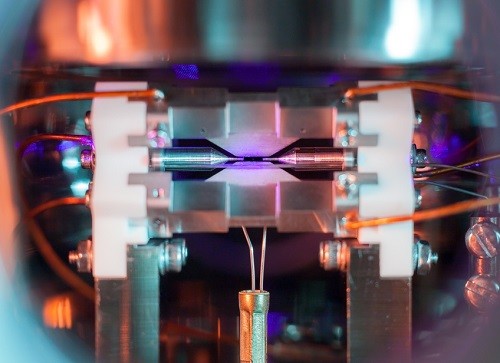
Pale blue dot: image of a strontium atom in an ion trap bags national photography prize (courtesy: David Nadlinger – University of Oxford)
By Michael Banks
An image of a single positively-charged strontium atom that is held in an ion trap by electric fields has won a national science photography competition organised by the UK’s Engineering and Physical Sciences Research Council.
Taken by PhD student David Nadlinger from the University of Oxford, the image shows the light emitted from the atom when it absorbs laser light tuned to a specific frequency. The picture was taken through a window of the ultra-high vacuum chamber that houses the ion trap.
“The idea of being able to see a single atom with the naked eye had struck me as a wonderfully direct and visceral bridge between the minuscule quantum world and our macroscopic reality,” says Nadlinger. “When I set off to the lab with camera and tripods one quiet Sunday afternoon, I was rewarded with this particular picture of a small, pale blue dot.”
Moving onto space, the successful launch of SpaceX‘s Falcon Heavy rocket last week resulted in a Tesla Roadster (formally owned by SpaceX boss Elon Musk) in orbit around the Sun. Used only as a test mass, the car featured a spacesuit-clad mannequin called “Starman” in the driver’s seat.
Grabbing a slice of the pie in the sky
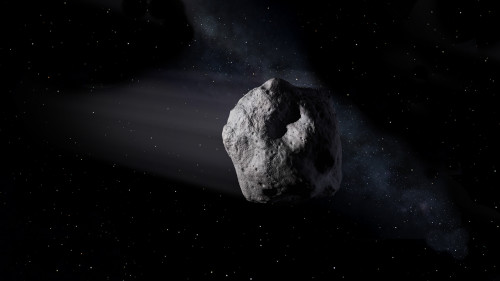
(Courtesy: NASA)
By Margaret Harris at the European Planetary Science Congress in Riga, Latvia
If you wanted to mine an asteroid, what would you need? Right now, it’s a hypothetical question: only a handful of spacecraft have ever visited an asteroid, and fewer still have studied one in detail. As commercial ventures go, it’s not exactly a sure thing. But put that aside for a moment. If you wanted to create an asteroid-mining industry from scratch, how would you do it?
Well, for starters, you’d need to know which asteroids to target. “Not every mountain is a gold mine, and that’s true for asteroids too,” astrophysicist Martin Elvis told audience members at the European Planetary Science Congress (EPSC) yesterday. For every platinum-rich asteroid sending dollar signs into investors’ eyes, Elvis explained there are perhaps 100 commercially useless chunks of carbon whizzing around out there, and the odds for water-rich asteroids aren’t much better. Moreover, some of those valuable asteroids will be impractical to mine, either because of their speed and location or because they’re too small to give a good return on investment. “Smaller asteroids aren’t even worth a billion dollars,” Elvis scoffed. “Who’d get out of bed for that?”
View all posts by this author | View this author's profile
Chasing gravitational waves in song, physicists on Broadway, the ‘impossible space engine’ returns
By Hamish Johnston
These days anyone making a major breakthrough in physics is expected to follow-up with a cheesy music video. So give it up for The Mavericks and “Chasing the Waves”, which chronicles the quest to detect gravitational waves – which culminated in LIGO’s success earlier this year. I don’t much about this video, but it seems to have been filmed at the University of Glasgow, which is part of the LIGO collaboration.
View all posts by this author | View this author's profile
Russian physics comes in from the cold

Physics powerhouse: the main building of the Moscow Institute of Physics and Technology. (Courtesy: Andrey Gusev)
By Susan Curtis in Moscow
It takes less than four hours to fly to Moscow from London, but it feels much more distant and mysterious. Even my colleagues at Physics World, who pride themselves on covering all of physics in all parts of the world, admit to a bit of a blind spot when it comes to Russian science, even though Russia has a strong tradition in physics as well as in mathematics and space science.
View all posts by this author | View this author's profile
Pushing towards the human–Martian frontier
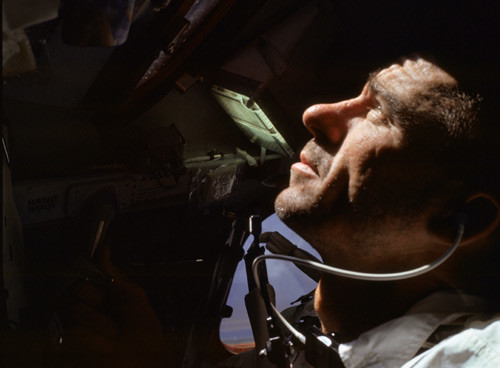
Eye on the sky: NASA astronaut Walter Cunningham during the Apollo 7 mission, in October 1968. (Courtesy: NASA)
By Tamela Maciel at the National Space Centre in Leicester
Last week, the planet Mars was under the international spotlight once more as NASA scientists announced that liquid water may still be flowing on the surface of the red planet. Also, the much-anticipated film adaptation of The Martian – a 2011 novel by American author Andy Weir – a science-driven story of human survival on Mars, hit the box office. Mars was also the hot topic at a recent event held at the National Space Centre in Leicester. The guest of honour was Apollo 7 astronaut Walter Cunningham and throughout the hour-long Q&A, he emphasized the need to push the “next frontier” and send humans to Mars.
Cunningham is not a man lacking in confidence or the experience of pushing boundaries. When asked if he ever felt the pressure of the astronaut selection or training process, he said “I thought I could fly anything, any time, anywhere. Was that true? I don’t know. But that’s how I felt.”
View all posts by this author | View this author's profile
Pluto fly-by: New Horizons sails past cold, distant world
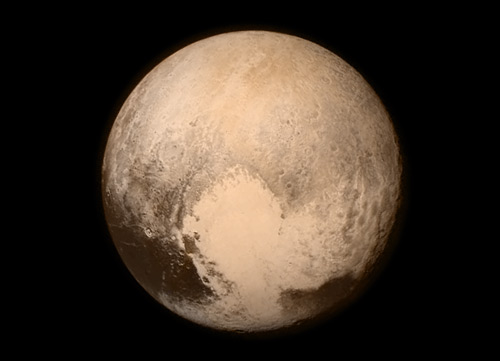
Perfect view: the sharpest image of Pluto to date taken by the New Horizons spacecraft. (Courtesy: NASA)
By Tushna Commissariat
After trundling through our solar system for more than 10 years, NASA’s New Horizons mission made its closest approach to the dwarf planet Pluto earlier today, at 12:49 BST. It was a mere 12,472 km from the planet’s surface – roughly the same distance from New York to Mumbai, India – making it the first-ever space mission to explore a world so far from Earth.
If you want to find out more about the New Horizons mission, read this recent news story by physicsworld.com editor Hamish Johnston. Above is best close-up view of this cold, unexplored world that the spacecraft sent back before its closest approach (when it was still 766,000 km from the surface), revealing in clear detail many of the planet’s surface features, including the “heart” at the bottom.
View all posts by this author | View this author's profile
Philae comet lander set for reboot
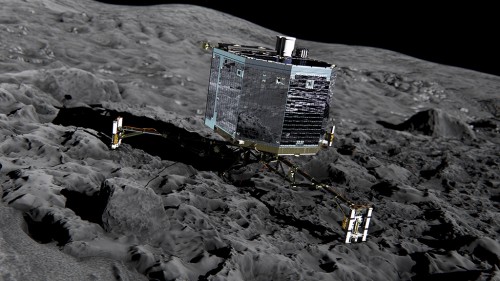
Here comes the Sun: the Philae lander may reawaken soon. (Courtesy: ESA/ATG medialab)
By Michael Banks
Scientists at the European Space Agency (ESA) are hoping that the Philae lander, which successfully landed on a comet last year, will re-establish contact soon as it travels closer to the Sun. Philae was part of ESA’s Rosetta mission that was launched in 2004 but when Philae separated from Rosetta in November, it landed on the comet in an awkward position. This meant that the craft’s solar panels did not receive enough sunlight to recharge its battery, but the lander’s 10 instruments were able to carry out measurements before it went into hibernation mode about 50 hours after landing.
View all posts by this author | View this author's profile
Last chapter in Rosetta’s Philae lander story…for now
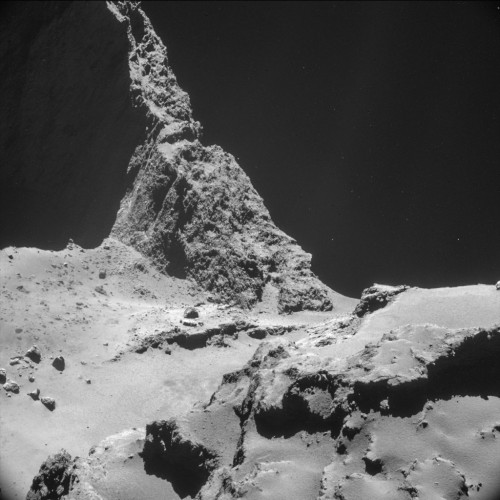
Strange new world: Image of comet 67P taken by Rosetta’s NAVCAM from 10km away.
(Courtesy: ESA/Rosetta/NAVCAM, CC BY-SA 3.0 IGO)
By Tushna Commissariat
Last week was exciting and exhausting for anyone involved in space exploration and astronomy, after scientists working on the Rosetta mission of the European Space Agency (ESA) made history when their “Philae” module touched down safely on the surface of comet 67P/Churyumov–Gerasimenko. But soon after celebrating Philae’s successful landing, a dramatic story unfolded. With a bumpy triple landing, harpoons that did not fire and tether the probe, as well as a final resting spot that lay in the shadows, which meant its solar panels received very little sunlight, Philae’s tumultuous story captivated the interest of thousands of people across the globe.
In the early hours of Saturday morning, as Philae’s batteries slowly drained of power, thousands mourned. “So much hard work..getting tired…my battery voltage is approaching the limit soon now,” Tweeted the Philae crew, and yet, the lander’s story was ultimately happy and successful. Although it spent only 57 “active” hours on the comet, ESA mission scientists were happy to report that the lander had indeed completed the entirety of its primary science mission.
View all posts by this author | View this author's profile
Rosetta’s Philae starts drilling into comet surface
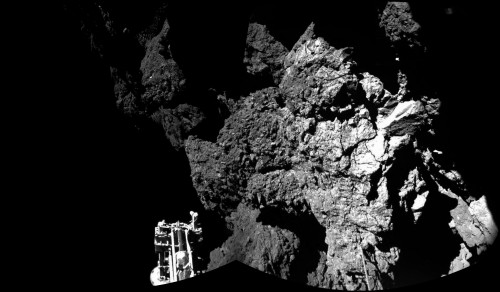
View of a lifetime: Philae safely on the surface of Comet 67P.
(Courtesy: ESA/Rosetta/Philae/CIVA)
By Tushna Commissariat
It had clearly been a long and busy 24 hours for members of the Rosetta mission at the European Space Agency (ESA) as they gave the latest updates in today’s Google+ Hangout. On Wednesday the mission made history as its “Philae” module touched down safely on the surface of Comet 67P/Churyumov–Gerasimenko. But there has been a great deal of drama and uncertainty since then, as it emerged yesterday that the lander’s final resting spot was more than 1 km away from where it was meant to arrive. Also, Philae is thought to be precariously positioned in the shadows on the far side of a large crater, where its solar panels cannot get enough light to operate as planned. Despite these hurdles, the lander’s many instruments have been functioning well and sending data back to Earth, via the Rosetta orbiter.
View all posts by this author | View this author's profile
Creepy comic, Hawking joins Monty Python and that shirt

Frame 142 in Randall Munroe’s series of Philae sketches. (Courtesy: xkcd.org)
By Hamish Johnston
The big story this week is that Rosetta’s Philae lander has touched down on a comet. During the descent, cartoonist and former physicist Randall Munroe captured the event in a series of 142 sketches. You can see the final instalment above, presumably drawn before Philae’s various problems were widely known.
View all posts by this author | View this author's profile